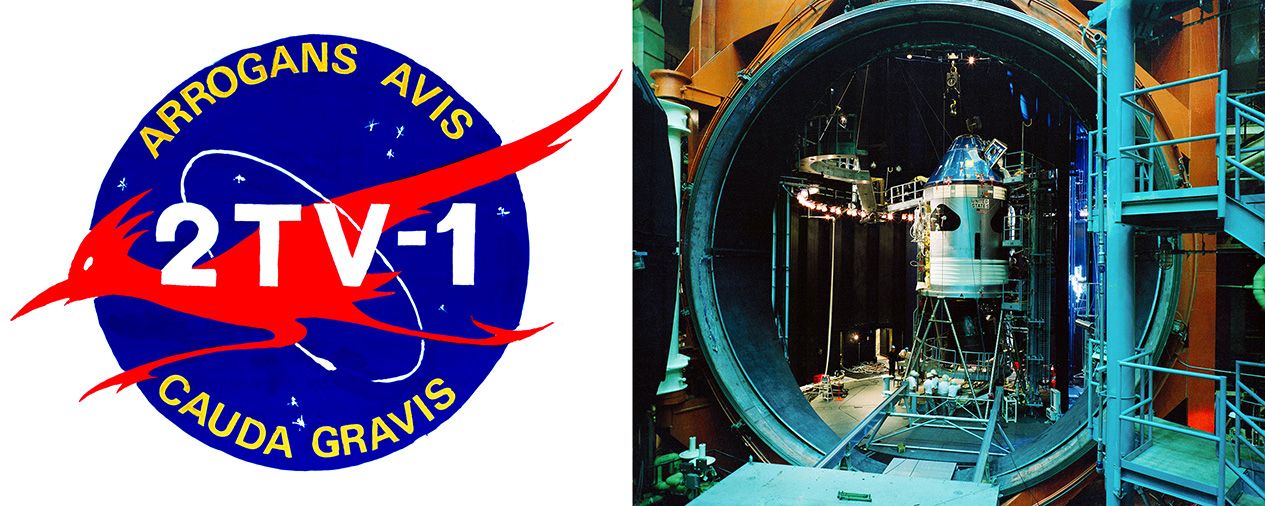In the late spring of 1968, NASA conducted two critical tests at the Manned Spacecraft Center in Houston to certify components of the Apollo spacecraft for human space flight. These thermo-vacuum tests, conducted in the Space Environment Simulation Laboratory (SESL), verified the space-worthiness of the Command Module (CM) and the Lunar Module (LM). Successful completion of both tests were constraints to the first manned flight of each vehicle – Apollo 7 in the case of the CM and (at the time) Apollo 8 for the LM.
Completed in 1965, the SESL houses two chambers for thermo-vacuum testing of large spacecraft. Chamber A is a 120-foot high, 65-foot diameter stainless steel vessel and can simulate pressures and temperatures equivalent to 130 miles above the Earth. Chamber B is smaller and was the site of successful thermo-vacuum tests of the LM, using Lunar Module Test Article (LTA) 8, in May 1968. Although the chambers tested spacecraft before the Apollo fire in January 1967, the LTA-8 and 2TV-1 tests were the first conducted under safety criteria revised as a result of the accident.
The primary purpose of the 2TV-1 thermo-vacuum testing was to ensure that the CM maintained the proper environment for crew and equipment in the vacuum and temperature extremes of space, as would be experienced during an Earth orbital flight. North American Rockwell Corporation in Downey, California, built the CM for the 2TV-1 tests to simulate Apollo 7’s configuration, and delivered it to MSC in April 1968. During the tests, the chamber exposed the CM to temperatures as high as 150o F using an array of brilliant carbon-arc lamps to simulate solar heating and as low as -150o F by running super cold liquid through the inner wall of the chamber. The spacecraft rested on a rotating platform to simulate how the spacecraft would rotate in a so-called “barbecue” mode on its way to the Moon to even out heating on its surface. According to 2TV-1 test manager Robert Wren, successful completion of the thermo-vacuum test required about 700-800 full time personnel.
For the 2TV-1 test NASA selected astronauts Joseph P. Kerwin as Commander, Vance D. Brand as CM Pilot and Joseph H. Engle as LM Pilot. The crew, wearing Apollo A6L space suits, entered the CM on June 16, 1968, and closed the spacecraft’s hatch. Based on lessons learned from the Apollo fire and in accordance with NASA’s decision in March 1968, the cabin’s atmosphere at the beginning of the test was a mixture of 60 percent oxygen and 40 percent nitrogen at a pressure of 16 pounds per square inch. Engineers then pumped Chamber A down to vacuum and replaced the cabin’s atmosphere with pure oxygen at five pounds per square inch, the same procedure followed in an actual spaceflight.
During the next eight days, the crew performed many of the functions as if on an actual spaceflight, including eating and sleeping. They operated guidance and navigation equipment, activated and checked out spacecraft systems and simulated engine firings. Meanwhile, chamber operators put the spacecraft through several phases of the thermo-vacuum test, beginning with a 15-hour hot soak with the arc lamps aimed at the CM, followed by a 15-hour cold soak with the lamps off. Then they aimed the lamps at the side of the Service Module for 45 hours, followed by 71 hours of alternate and contingency operations, ending with a 12-hour entry phase. The spacecraft performed very well throughout the test, with only a few minor anomalies reported. The crew egressed from the spacecraft on June 24, having spent 177 hours in the CM. Recommendations from the test resulted in 12 hardware design and 13 crew procedure changes for the Apollo 7 mission.
Commander Kerwin summarized the test: “We had all the fireproof materials…in the vehicle. So we felt like we were breaking some ground and doing some necessary testing to enable the…flight of Apollo 7.” Engle added somewhat humorously:
“We didn’t think of it as being quite such a monumental thing. We were kind of bored in there, actually. I think I pulled on my hunting and camping skills to living in a confined area. Being confined in a tent while it’s raining for several days, with a couple of guys, that was good training for 2TV-1.”
According to MSC Structure and Mechanics Division Chief Joseph N. Kotanchik, successful completion of the 2TV-1 thermo-vacuum test was a “significant milestone in the Apollo program,” with “no constraints on proceeding with [Apollo 7].” The test brought the Moon landing goal closer to reality.
Read James McLane’s and Robert Wren’s recollections of the SESL from their oral histories with the JSC History Office.
































